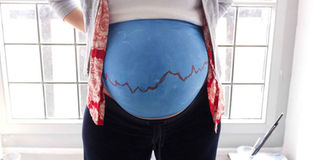Sports medicine used to diagnose childbirth injuries

Childbirth is as traumatic as many endurance sports. A study found that women can take eight months or longer to heal from pelvic injuries sustained during childbirth. PHOTO | FILE
What you need to know:
- Women can take eight months or longer to heal from pelvic injuries sustained during childbirth, and in some cases the Kegel exercises commonly prescribed do not work at all.
- Study showed that one-quarter of women showed fluid in the pubic bone marrow or sustained fractures similar to a sports-related stress fracture, and two-thirds showed excess fluid in the muscle, which indicates injury similar to a severe muscle strain.
Is childbirth an athletic event? Well, researchers from the University of Michigan in the US have used sports medicine to diagnose injuries caused by deliveries, the institution said in a press release on Tuesday.
They reasoned that using magnetic resonance imaging (MRI) to diagnose childbirth injuries — a technique usually reserved for sports medicine — makes sense because childbirth is as traumatic as many endurance sports.
They found that women can take eight months or longer to heal from pelvic injuries sustained during childbirth, and in some cases the Kegel exercises commonly prescribed do not work at all.
MUSCLE STRAIN
Janis Miller, associate professor at university’s School of Nursing, and a team of midwives, radiologists and obstetricians studied a group of pregnant women at high risk for pelvic muscle tears and used MRI to diagnose injury and track healing time. Previously, experts thought that postpartum pelvic injuries were primarily nerve-to-muscle related.
But the images in Ms Miller’s study showed that one-quarter of women showed fluid in the pubic bone marrow or sustained fractures similar to a sports-related stress fracture, and two-thirds showed excess fluid in the muscle, which indicates injury similar to a severe muscle strain. Forty-one per cent sustained pelvic muscle tears, with the muscle detaching partially or fully from the pubic bone.
Kegels are the most commonly prescribed exercise, but they can not reattach pelvic muscles to the pubic bone – nothing can. Many women do these exercises religiously but do not heal as they have been told they would, Ms Miller said.
She stressed that the participants were selected for high-risk factors of muscle tear, and are not representative of the population of expectant mothers. Most injuries including all fractures healed by the eight-month return visit time.
Miller hopes the study derails the one-size-fits-all approach to treating postpartum injuries so women will stop blaming themselves if problems linger.





